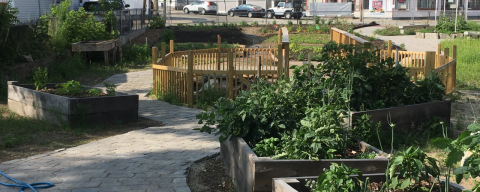What are the benefits of raised beds and how can I construct one myself?
Raised beds are a great option for pretty much any garden situation, especially if you only have a small amount of space. Raised beds are often more productive than beds in the ground because the soil is less compacted, has better drainage, and warms earlier in the spring, meaning that plants will start to grow earlier in the season. Raised beds are also often easier to maintain, particularly for people with limited mobility, and generally have less perennial weed pressure. The main disadvantages are that they tend to require more frequent irrigation and have a high initial cost of construction. Those obstacles aside, raised beds can be a great choice for almost anyone interested in vegetable gardening.
Construction
When it comes to constructing raised beds, there are no set rules. Many gardeners are content to purchase kits from garden supply companies, while others venture to build their own. There are countless designs available in books and online, some of which are better than others. Ideally, raised beds will be no more than four feet wide so that you are able to easily reach the center of the bed without stepping on the soil. After all, one of the main benefits of having raised beds is less compaction and better soil structure. As long as the beds are an appropriate width they can be any shape and length you like.
In addition, raised beds need to be high enough to accommodate sufficient soil for plant roots. Aim to make beds six inches or taller. Many vegetable crops grow best if they have at least a foot of soil to support their root systems.
There are many options when it comes to construction materials for your raised beds. If you choose to use wood, opt for non-treated, rot resistant lumber like cedar, oak, or locust as there is concern that treated wood may leach heavy metals into the soil that could be taken up by plants. If you happen to have treated lumber at your disposal, you can always line the beds with thick plastic to form a barrier between the soil and wood. Other worthy materials to consider for raised beds include bricks, rocks, cinder blocks, and plastic decking material. Essentially, as long as the building material can hold soil and doesn’t contain any toxic substances, feel free to use it.
Soil
Although most vegetables will grow well in soilless potting mix, it’s often prohibitively expensive to fill an entire raised bed with such. Instead, most gardeners elect to fill their raised beds with a combination of quality garden soil and compost. Some mulch yards sell topsoil and compost blends, or you can use soil from your property and mix in compost yourself. Either way, you’ll want to aim for no more than 50% organic matter. Ideally, compost will make up 10-20% of the total soil volume. And just like gardening in the ground, it’s always a good idea to get the soil tested to make sure proper amendments are added.
Placement
As in any other vegetable garden, raised beds should be sited in a spot that receives at least six hours of direct sun daily. In terms of maintenance it’s also a good idea to place the beds near the house, or at least close to a water source to facilitate irrigation. If you decide to build more than one raised bed, make sure there is a wide enough path between them for easy travel, harvest, and upkeep.
Got questions? The Ask UNH Extension Infoline offers practical help finding answers for your home, yard, and garden questions. Call toll free at 1-877-398-4769, Monday to Friday, 9 a.m. to 2 p.m., or e-mail us at answers@unh.edu.
Do you love learning about stuff like this?
SUBSCRIBE TO Granite State Gardening newsletter
Got questions? The UNH Extension Yard and Garden Infoline offers practical help finding answers for your yard and garden questions.
Call toll free at 1-877-398-4769, Monday to Friday, 9 a.m. to 2 p.m., or fill out webform.

